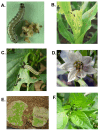Fecal Transmission of Nucleopolyhedroviruses: A Neglected Route to Disease?
- PMID: 40558992
- PMCID: PMC12192623
- DOI: 10.3390/insects16060562
Fecal Transmission of Nucleopolyhedroviruses: A Neglected Route to Disease?
Abstract
Nucleopolyhedroviruses of lepidopteran larvae (Alphabaculovirus, Baculoviridae) form the basis for effective and highly selective biological insecticides for the control of caterpillar pests of greenhouse and field crops and forests. Horizontal transmission is usually achieved following the release of large quantities of viral occlusion bodies (OBs) from virus-killed insects. In the present review, I examine the evidence for productive midgut infection in different host species and the resulting transmission through the release of OBs in the feces (frass) of the host. This has been a neglected aspect of virus transmission since it was initially studied over six decades ago. The different host-virus pathosystems vary markedly in the quantity of OBs released in feces and in their ability to contaminate the host's food plant. The release of fecal OBs tends to increase over time as the infection progresses. Although based on a small number of studies, the prevalence of transmission of fecal inoculum is comparable with that of recognized alternative routes for transmission and dissemination, such as cannibalism and interactions with predators and parasitoids. Finally, I outline a series of predictions that would affect the importance of OBs in feces as a source of inoculum in the environment and which could form the basis for future lines of research.
Keywords: Alphabaculovirus; Baculoviridae; Lepidoptera; frass; midgut infection.
Conflict of interest statement
The author declares no conflicts of interest.
Figures




Similar articles
-
Fecal Transmission of Spodoptera frugiperda Multiple Nucleopolyhedrovirus (SfMNPV; Baculoviridae).Viruses. 2025 Feb 21;17(3):298. doi: 10.3390/v17030298. Viruses. 2025. PMID: 40143229 Free PMC article.
-
The clinical effectiveness and cost-effectiveness of enzyme replacement therapy for Gaucher's disease: a systematic review.Health Technol Assess. 2006 Jul;10(24):iii-iv, ix-136. doi: 10.3310/hta10240. Health Technol Assess. 2006. PMID: 16796930
-
A rapid and systematic review of the clinical effectiveness and cost-effectiveness of paclitaxel, docetaxel, gemcitabine and vinorelbine in non-small-cell lung cancer.Health Technol Assess. 2001;5(32):1-195. doi: 10.3310/hta5320. Health Technol Assess. 2001. PMID: 12065068
-
Differently different?: A commentary on the emerging social cognitive neuroscience of female autism.Biol Sex Differ. 2024 Jun 13;15(1):49. doi: 10.1186/s13293-024-00621-3. Biol Sex Differ. 2024. PMID: 38872228 Free PMC article. Review.
-
Systemic pharmacological treatments for chronic plaque psoriasis: a network meta-analysis.Cochrane Database Syst Rev. 2021 Apr 19;4(4):CD011535. doi: 10.1002/14651858.CD011535.pub4. Cochrane Database Syst Rev. 2021. Update in: Cochrane Database Syst Rev. 2022 May 23;5:CD011535. doi: 10.1002/14651858.CD011535.pub5. PMID: 33871055 Free PMC article. Updated.
References
-
- ICTV International Committee on Taxonomy of Viruses. Family Baculoviridae. 2025. [(accessed on 12 April 2025)]. Available online: https://ictv.global/report/chapter/baculoviridae.
-
- Possee R.D., Chambers A.C., Graves L.P., Aksular M., King L.A. Recent developments in the use of baculovirus expression vectors. Curr. Issues Mol. Biol. 2019;34:215–230. - PubMed
-
- Moore S., Jukes M. Advances in microbial control in IPM: Entomopathogenic viruses. In: Kogan M., Heinrichs E.A., editors. Integrated Management of Insect Pests. Burleigh Dodds Science Publishing; Sawston, UK: 2019. pp. 593–648.
-
- Rohrmann G.F. Baculovirus Molecular Biology. 4th ed. National Center for Biotechnology Information; Bethesda, MD, USA: 2019. [(accessed on 10 April 2025)]. Available online: https://www.ncbi.nlm.nih.gov/books/NBK543458.
Publication types
LinkOut - more resources
Full Text Sources

